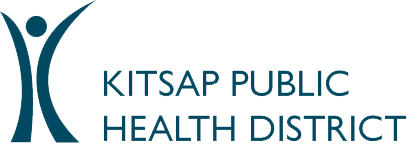
Actions Requested
- Be aware that tuberculosis (TB) continues to circulate in the Puget Sound Region. Kitsap County has on average three new TB cases each year. The Washington State Department of Health (DOH) has recently issued a press release reporting a 22% rise in statewide TB cases from 2020 to 2021. Recently diagnosed Kitsap cases may have exposed several people in the community.
- “Think TB”. Consider TB disease in patients with compatible clinical and radiological features, including the following: persistent cough for more than three weeks, non-resolving pneumonia, upper lobe infiltrates, miliary, nodular or cavitary lesions.
- Specialty providers such as oncologists, gastrointestinal (GI) specialists, and endocrinologists should consider TB in patients referred to them who have risk factors for TB and whose symptoms are not explained by other etiologies.
- Be aware that many persons with active TB do not have a “classic presentation”. Consider TB in patients with illnesses of unspecified etiology and who are increased risk for TB, including people who have diabetes, are immunosuppressed, have a history of latent tuberculosis infection (LTBI), have been in close contact with someone who has active TB, have a history of residence or travel to a place where TB is endemic, or have a history of living or working in a prison.
- Exercise high suspicion for TB in patients who have lived or were stationed in areas of the world with TB transmission. More than 85% of cases reported in Kitsap County from 2017 – 2021 had spent extended time outside the continental U.S., in areas with high TB burden. Note that disruptions to health systems around the world have likely impacted TB detection and treatment, and thus increased the risk of exposure and infection to persons visiting these areas.
- Notify Kitsap Public Health District (KPHD) of any patient for whom active TB is suspected. This allows Public Health to initiate an investigation and identify and evaluate close contacts as soon as possible, and to limit further exposures. KPHD should be considered a resource for answering clinical questions, advising on, and coordinating, appropriate testing, as well as identifying resources for providers and patients. Active TB is notifiable to the local health jurisdiction (LHJ) as soon as it is clinically suspected in accordance with WAC 246-101.
- Call Kitsap Public Health 24/7 at 360-728-2235 or use the Reportable Disease Fax Form and fax to 360-813-1168 with any corresponding lab results.
- Ensure implementation of airborne infection isolation precautions when seeing patients with suspected or laboratory-confirmed pulmonary TB disease.
- Consider re-testing health care workers who have been exposed to an active tuberculosis case; in most cases, Interferon-Gamma Release Assay (IGRA) (QuantiFERON®-TB Gold In-Tube test (QFT-GIT) or T-SPOT®.TB test (T-Spot)) is recommended. Annual TB testing of health care personnel is not recommended unless there is a known exposure or ongoing transmission.[1]
Background
- KPHD is aware of two recent TB exposure events which may have affected Kitsap County residents:
- The Washington State Department of Health (DOH), U.S. Centers for Disease Control and Prevention (CDC), and Washington State Department of Corrections (DOC) are currently investigating an ongoing outbreak of tuberculosis associated with the state’s prison system. At least 17 cases of TB disease have been identified throughout the state since August 2021 and more potential cases are being evaluated presently. Investigators estimate that more than 1,500 individuals might have been exposed, including current Kitsap residents.
- An additional active TB case was recently diagnosed in a Kitsap resident unrelated to the above-mentioned outbreak. We are investigating possible public and community exposures and working with the organizations and people potentially exposed as part of the ongoing contact investigation.
- Tuberculosis continues to be sporadically identified and diagnosed in Kitsap residents. One to eight cases of active tuberculosis are diagnosed in Kitsap residents every year. From 2017 – 2021, 16 cases of active tuberculosis were reported in Kitsap County. Of those:
- More than 85% had spent extended time outside of the continental US; however, of those 13 cases, at least 50% had been living in the US for 10 years or more.
- Less than 50% were initially evaluated because of TB symptoms; 37% were evaluated because of an incidental lab result or abnormal chest radiograph.
- Three of the 16 cases died of TB or complications associated with TB.
- Two cases from the past five years illustrate how patients can present to multiple levels of care, and how they can potentially be missed:
Case 1: A Kitsap resident in their 60s who initially presented to a hospital emergency department with fever, six months of coughing, weight loss, tachycardia, right lower lobe infiltrate and pleural effusion, and pulmonary mass nodules. They were prescribed augmentin and azithromycin and were referred to Hematology/Oncology. The patient had immigrated to the United States from a country with high TB burden more than 30 years prior to symptom onset. They had multiple visits with Hematology/Oncology and Pulmonary specialists over the next six months. Cytology was negative and cancer was ruled out. Although a radiologist observed “findings…worrisome for mycobacterial infection”, no further workup for TB was done. The patient had numerous additional visits with their primary care provider, who monitored severity of symptoms and recommended fluids and rest. Fourteen months after their initial ED visit, they were admitted to the hospital with dyspnea. Sputum collected following admission showed 4x AFB. The patient died 47 days after admission.
Case 2: A Kitsap resident in their 30s who initially presented to urgent care with an upper respiratory infection and bronchitis. They were prescribed a Z-pack and sent home. The patient had arrived from a country with high TB burden two years prior to symptom onset and was otherwise healthy, with no history of TB or lung disease. Two months after their initial urgent care visit, they visited another urgent care, presenting with a chronic cough and severe weight loss (33 lbs). They were referred for specialty consult. Four days later they were admitted to the hospital and later diagnosed with active pulmonary TB complicated left upper lobe necrosis and hydropneumothorax, right ventricular failure and volume overload. The patient died within 35 days of initial admission.
- According to the CDC, there were 7,860 cases of TB reported in the U.S. in 2021. The CDC estimates a further 13 million may be living with latent TB infection. According to their 2020 report, the most commonly observed medical risk factor among cases was diabetes mellitus (22.5%). Although coinfection with human immunodeficiency virus is frequently observed in some regions of the world, fewer than 5% of 2020 TB cases in the United States were HIV-positive.
TB Testing
- Two types of tests are recommended for initial TB diagnosis: (1) Interferon-Gamma Release Assay (IGRA) (QuantiFERON®-TB Gold In-Tube test (QFT-GIT) or T-SPOT®.TB test (T-Spot)), and (2) tuberculosis skin test (TST, PPD, Mantoux). In most situations, an IGRA is recommended due to improved specificity, not requiring a second patient visit, and results not being affected by patient history of BCG.
- Guidelines for Testing and Diagnosis (CDC): https://www.cdc.gov/tb/publications/factsheets/testing/tb_testing.htm
- TB Screening and Testing of Health Care Personnel (CDC): https://www.cdc.gov/tb/topic/testing/healthcareworkers.htm
- TST vs. IGRAs (CDC): https://www.cdc.gov/tb/webcourses/course/chapter3/3_testing_for_tb_disease_and_ltbi_3_mantoux_tuberculin_skin_test_tst_vs_igras.html
Management of Contacts
- Work in partnership with KPHD to promptly evaluate patients who are identified as a contact to a person with infectious TB. Use an IGRA (preferred) or TST, and if the TB test is positive or the patient is symptomatic, a chest radiograph. Initiate treatment for latent TB infection after exclusion of active TB disease, as described in the DOH TB Provider Toolkit.
Tuberculosis Prevention Patient Education
Share with patients:
Contacting the Health District
- Call (360) 728-2235 and leave a message. Includes reporting notifiable conditions 24 hours a day, 7 days a week. Leave the patient’s name, date of birth and disease.
- Fax (360) 813-1168.
Additional Resources
- Kitsap Public Health District Tuberculosis Program
- DOH TB Provider Toolkit
- CDC Tuberculosis Resources for providers
- CDC TB Guidelines for Infection Control and Health Care Personnel
- CDC TB Infection Control in Health-Care Settings
- WHO Tuberculosis Factsheet
- WHO Global Tuberculosis Report 2021
[1] Sosa LE, Njie GJ, Lobato MN, et al. Tuberculosis Screening, Testing, and Treatment of U.S. Health Care Personnel: Recommendations from the National Tuberculosis Controllers Association and CDC, 2019. MMWR Morb Mortal Wkly Rep 2019;68:439–443. DOI: http://dx.doi.org/10.15585/mmwr.mm6819a3
